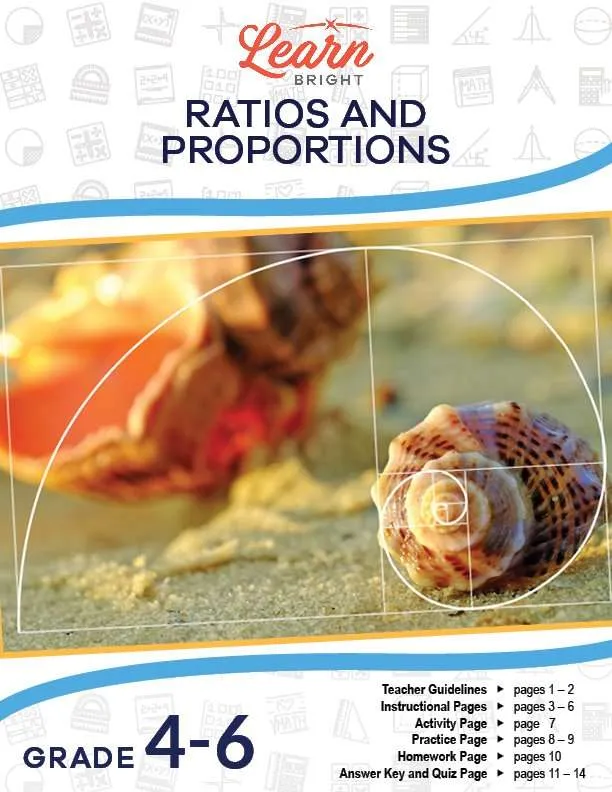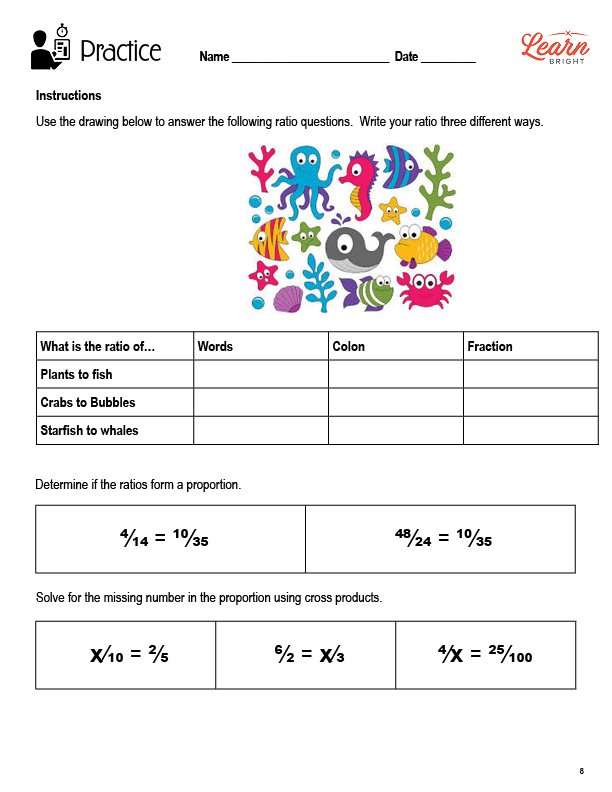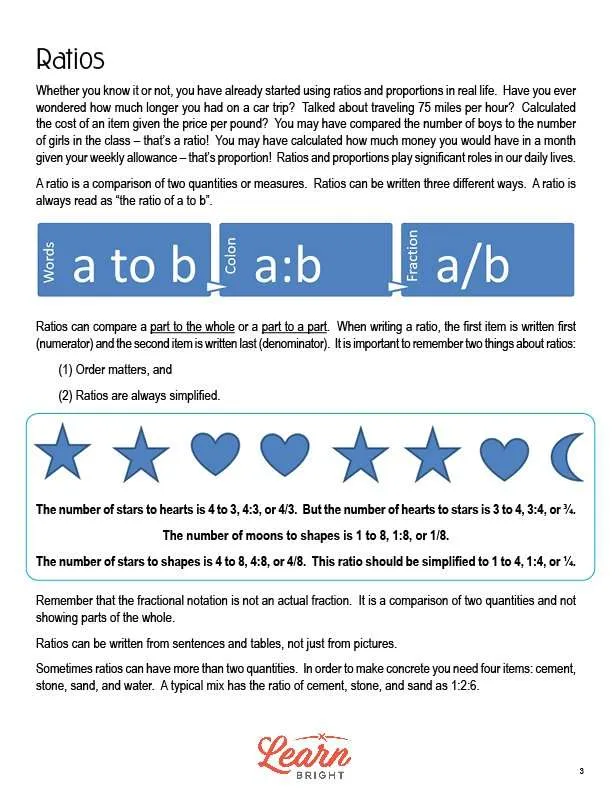Description
What our Ratio and Proportion lesson plan includes
Lesson Objectives and Overview: Ratio and Proportion teaches students about ratios and proportions, including relevant vocabulary and various applications of these concepts. At the end of the lesson, students will be able to understand and apply ratios to groups of objects, compute rate of change, use cross products in proportions to solve for missing values, and use tables and graphs to solve real-world problems. This lesson is for students in 4th grade, 5th grade, and 6th grade.
Classroom Procedure
Every lesson plan provides you with a classroom procedure page that outlines a step-by-step guide to follow. You do not have to follow the guide exactly. The guide helps you organize the lesson and details when to hand out worksheets. It also lists information in the blue box that you might find useful. You will find the lesson objectives, state standards, and number of class sessions the lesson should take to complete in this area. In addition, it describes the supplies you will need as well as what and how you need to prepare beforehand.
Options for Lesson
Included with this lesson is an “Options for Lesson” section that lists a number of suggestions for activities to add to the lesson or substitutions for the ones already in the lesson. One optional addition to this lesson is to have your students use photocopied maps to determine distances, time, and rates for traveling; they can use this information to plan a trip to a city and calculate the miles, amount of gas, time, and rate. You could also have your students play a variation of Around the World using proportion cards to show equivalency or to solve for a missing value. Finally, you could have your students create a scale model of the classroom including walls, windows, desks, and chairs by taking measurements and creating a scale.
Teacher Notes
The teacher notes page includes lines that you can use to add your own notes as you’re preparing for this lesson.
RATIO AND PROPORTION LESSON PLAN CONTENT PAGES
Ratios
The Ratio and Proportion lesson plan includes four content pages. People use ratio and proportions every day without realizing it! Have you wondered how much longer you had on a car trip? Talked about traveling 75 miles per hour? Calculated the cost of an item given the price per pound? Ratios and proportions play significant roles in our day-to-day lives.
Ratios are comparisons of two quantities or measures. You can write ratios in three different ways. You always read ratios as “the ratio of a to b.”
With ratios, you can compare a part to the whole or a part to a part. To write a ratio, write the first item first (numerator) and the second item last (denominator). When using ratios, always remember that order matters and that ratios are always simplified.
Let’s consider an example. The lesson shows a series of shapes (stars, hearts, and moons). The number of stars to hearts is 4 to 3, 4:3, or 4/3. However, the number of hearts to stars is 3 to 4, 3:4, or 3/4. The number of moons to shapes is 1 to 8, 1:8, or 1/8. The number of stars to shapes is 4 to 8, 4:8, or 4/8. You need to simplify this ratio to 1 to 4, 1:4, or 1/4.
Ratios written in fractional notation are not actually fractions! They are comparisons of two quantities and do not show parts of a whole. You can write ratios from sentences and tables in addition to pictures.
Some ratios have more than two quantities. For example, there are four items needed to make concrete: cement, stone, sand, and water. A standard mix of concrete has the ratio of cement, stone, and sand as 1:2:6.
Rates
Rates are a type of ratio that compare two different types of units. Distance and time are both rates. When shopping, you might see a rate—a sign advertising a 14 ounce can of Super Spaghetti Sauce for $3.29 tells you that the rate is $3.29 for 14 ounces. You could write this rate three ways: $3.29 to 14 ounces, $3.29:14 or $3.29/14. Cents and ounces are two different units used in this ratio.
Unit rates are the most common types of rates. Unit rates are expressed in terms of one unit. In word problems, hey are often referred to as averages. There are three ways to solve unit rate problems. The formula is Part x Rate = Total.
The first method requires you to multiply. If you have the rate and the number of units, you simply multiply to find the total: Rate * Units = Total.
The second method requires you to divide. If you have the total and the number of units, divide to find the rate: Total ÷ Units = Rate.
Finally, the third method also requires you to divide. If you have the total and the rate, divide to find the number of units: Total ÷ Rate = Units.
Using the earlier example, a unit rate would be one ounce of spaghetti sauce. You have the total ($3.29) and the unit (14 ounces), so you need to calculate the rate. Since you have the total and the units, you divide to find the rate: 3.29 ÷ 14 = 0.235. Therefore, the spaghetti sauce costs 23.5 cents for 1 ounce.
But why would someone want to know how much one ounce of sauce costs? Maybe you need to figure out which sauce costs the least because you have a giant spaghetti party next weekend for 252 people! Maybe there’s also a sign in the aisle that says “Spicy Spaghetti Sauce only costs 22.5 cents per ounce for 18 ounces”. You have the rate and the units, so how do you figure out the total cost? Simply multiply 22.5 * 18 = $4.19. You can then use these rates to determine the total cost of each sauce for 252 people!
Proportions
Proportions are equations with two equivalent ratios. They tell you that two ratios are equal. For the proportion 2/4 = 5/10, 2/4 and 5/10 are ratios and = tells you that it’s an equation.
Two equivalent ratios always have equal cross products. If the cross products are not equal, then the ratios are not equal. Let’s look at an example of a proportion: a/b = c/d, ad = bc.
Proportion problems have two things that are changing at the same rate. To solve a proportion problem, the first step is to find the two things that are changing. Next, set up the proportion. Finally, use cross products to find the missing value.
Let’s look at an example. If Jason can read 3 books in 2 weeks, how many books can he read in 6 weeks?
First, find the two items that are changing: books and weeks. Next, set up the proportion: books/weeks = 3/2 = x/6. Then, cross multiply: 3*6 = 2*x. Finally, solve the one-step equation: 18 = 2x becomes x = 9. Jason can read 9 books in 6 weeks.
Always make sure the labels match the values when you set up a proportion!
Tables and Graphs
You can use ratios and proportions to help solve real world problems with tables and graphs. Let’s look at an example. You have been waiting for a great sale on apps and one finally appeared! You can buy any 4 apps for only $8. What would 12 apps cost?
First, you need to find the unit price for one app. Using the methods above, you know that you need to divide the total by the units: 8 ÷ 4 = 2. This means that your unit rate is 2. Every 1 app costs $2.00. Now that you know that each app costs only $2.00, you can multiply by 12 to find your total cost: 2*12 = 24. You can show this data in a chart.
Say you only have $16 left. How many apps can you buy with $16? To solve, divide the total amount of money by the cost of one app to find how many apps can be purchased: $16 ÷ $2 = 8. This means that you can buy 8 new apps!
You can then create a set of ordered pairs using your chart: {(1, 2), (4, 8), (8, 16), (12, 24)}. Finally, you can plot them on a graph!
RATIO AND PROPORTION LESSON PLAN WORKSHEETS
The Ratio and Proportion lesson plan includes four worksheets: an activity worksheet, a practice worksheet, a homework assignment, and a quiz. You can refer to the guide on the classroom procedure page to determine when to hand out each worksheet.
BASKETBALL ACTIVITY WORKSHEET
Students will work in groups of four to complete the activity worksheet. The students will fulfill four roles: (1) Time Keeper, (2) Recorder, (3) Basketball Retriever, and (4) Counter.
Each group will crinkle up the paper provided to create ‘basketballs’. They will then mark a free throw line on the ground so that each team member is the same distance from the basket. Each student’s goal is to make as many baskets as they can during their time. The time keeper says start and stop, the counter counts baskets, the retriever verifies baskets and hands out more balls if needed, and the recorder writes down the scores. The students take turns trying to make the most baskets as they can.
Once each student has had a turn, they will use the chart with their scores to calculate the rate and the unit rate for each team member. Finally, they will answer questions about the activity and process.
RATIO AND PROPORTION PRACTICE WORKSHEET
For the practice worksheet, students will use the drawing on the worksheet to answer ratio questions. They will write their ratio three different ways, using words, colons, and fractions. They will then determine if different ratios form proportions. Next, they will solve for the missing numbers in the given proportions using cross products.
Finally, they will solve five proportion problems by stating the two items being compared and drawing a graph for the final proportion problem.
DREAM BEDROOM HOMEWORK ASSIGNMENT
The homework assignment asks students to create a scale drawing of their dream bedroom, following the directions listed on the worksheet very carefully. First, they will decide the measurements of their bedroom. Next, they will decide the scale of their bedroom. After that, they will draw the room and some objects to go in the room. Finally, they will write their scale on their drawing and color, decorate, or add additional pieces to their drawing!
QUIZ
This lesson also includes a quiz that you can use to test students’ understanding of the lesson material. For the quiz, students will first write ratios in three different ways. Next, they will identify equivalent proportions. Finally, they will solve three word problems.
Worksheet Answer Keys
This lesson plan includes answer keys for the practice worksheet and the quiz. If you choose to administer the lesson pages to your students via PDF, you will need to save a new file that omits these pages. Otherwise, you can simply print out the applicable pages and keep these as reference for yourself when grading assignments.









